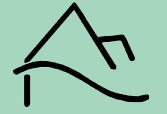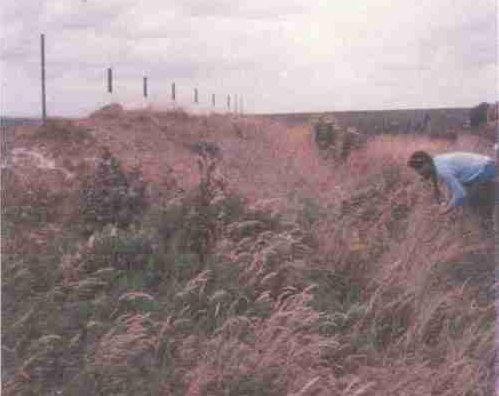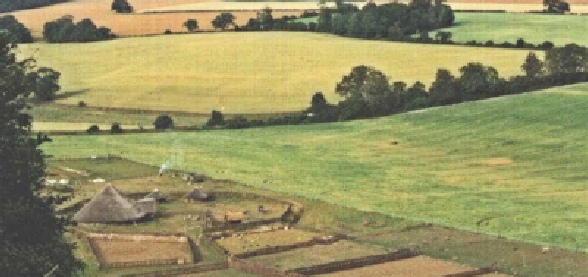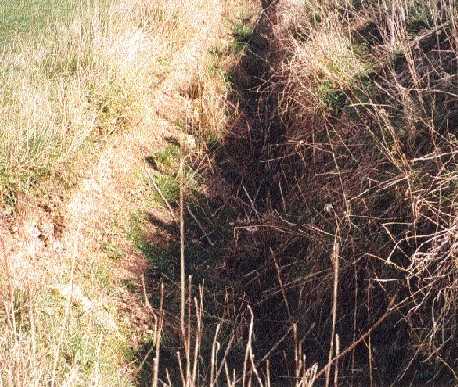


Sedimentation, Erosion and Plant Revegetation in Experimental Earthworks
This is another long term programme with international equivalents.
It is useful to show here the earthworks at Overton and Wareham Down, both for contrast and to show how designs have evolved consequent on the behaviour of th ese experimental systems.
ese experimental systems.
This somewhat hazy photograph shows Peter Reynolds inspecting the Overton Earthwork in 1986. This earthwork, inspired by the British Council for Archaeology, is arguably the first major UK experimental archaeology project, which studies far more than mere physical decay of the ditch and bank. (See Bell, M., Fowler, P. J. and Hillson, S., (1996) The experimental earthwork project 1960-
The Reynolds study focused on the behaviour of domestic scale ditch and bank constructs from the time of the initial construction. The earliest study used a construct based broadly on existing excavation data and from the understanding gained about the response to weather, plant colonisation and interference, the current octagonal layout of ditch and bank was devised so as to determine the effect of as many constructional variables as was practicable.
The octagonal layout gives maximum coverage of the effect of orientation to the prevailing weather. The bank construction is varied to study the effect of building it with or without a berm, between it and the ditch, and to test the interaction of this variable with initial turf coverage or not. More details here.
As well as the weather records, progress towards stabilisation of the system was followed by annual recording in July, of the nature and degree of revegetation, including periodic measurement of the physical profile of the ditch, where resources allowed. Photographic and, occasionally, video records were also made. This continued for some 15 years on the Bascomb, Fishbourne and Wroughton sites and then, as the earthworks became stabilised, less detailed recording was undertaken. Before being put out of commission by redevelopment, the Fishbourne earthwork vegetation was finally assessed and sections excavated through the bank and ditch and a study made of the of the original field surface that became buried under the bank. A team from University of Reading led by Prof. Martin Bell carried out this work and later conducted similar excavations at Bascomb..
A number of such earthworks have been built on a variety of rock/soil types, both in the UK and abroad. An appreciation of the early stages of recording the behaviour of a linear construct, as opposed to the preferred octagonal type, has been reported in Monografies D'Arqueilogia Medieval I Postmedieval No 3, University of Barcelona, 1998.
These studies are complementary to those on the major experimental earthworks at Overton, Wareham Down and Morden Bog in the UK.
The observations of the first eight years behaviour of one of the several earthworks under study has been reported in the Butser Monograph Series "The Butser Ancient Farm Earthworks Project : A first analysis of the data and a description and review of the methodology". For a brief extract click here
The Monograph details the background thinking to the design and construction of experimental earthworks and gives exacting descriptions of all the recording methodologies employed. The established background to such methods is presented, reviewed and critiqued against relevant references. Aspects of particle mechanics are presented to interpret the observed effects and the known behaviour of earlier experimental earthworks. The overall conclusions are given in the Summary.
Some aspects of the work are of equal interest to environmental and botanical studies. The recording system was designed to embrace this possibility from the outset.
Peter Reynolds’ original ideas on earthworks design were evolved following his involvement with the work on the first British Earthworks at Overton Down but he also visited Lejre, in Denmark, one of the earliest Iron Age study sites in Europe, where he became familiar with some concepts of construction and behaviour of buildings and earthworks. It has been learnt from a "find" in his papers that he looked at a 1946 publication by the Research Committee of the Society of Antiquaries of London, to review methodology used then.
For those not familiar with the appearance of the "standard design" of ditch and bank enclosure used by Butser Ancient Farm, the image of the Wroughton  Earthworks, almost immediately after construction, is shown below.
Earthworks, almost immediately after construction, is shown below.
The Wroughton Experimental Earthwork photographed from the north-
The Monograph describes, in the terminology of experimental results, how this appearance has changed with time. It also goes on to discuss how additional factors have been brought into the project in the last few years at the site of the earlier Fishbourne Earthworks and at the final Earthworks, at Bascomb Down, as shown below.
The work analysed in the Monograph relates entirely to a system where every effort was made to exclude external human or animal interference, the so- Spring/Summer.
Spring/Summer.
Bascomb Down: Arm C: The effect o f 7 years "undisturbed" weathering.
f 7 years "undisturbed" weathering.
Bascomb Down: Arm G: The effect of animal intrusion on the erosion of a corresponding arm.